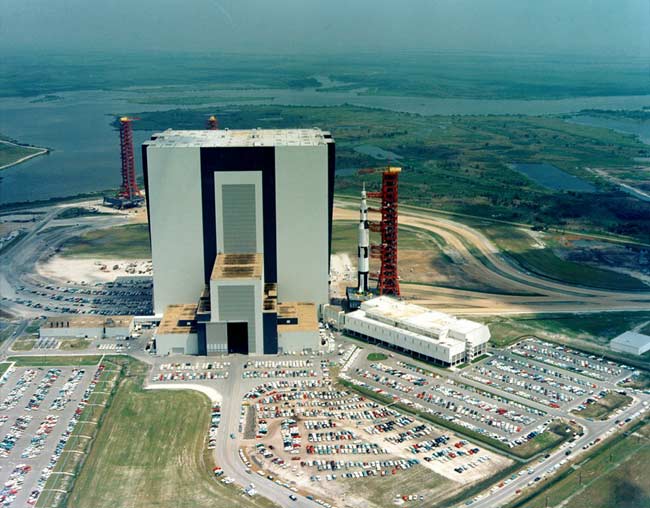How Tennis Shoes and Tug-of-War Toppled the Mighty Saturn V

The yearwas 1966 and NASA was testing its first fully-assembled, 36-story tall Saturn Vmoon rocket at its launch facilities in Florida. Despite the threat posed by ahurricane and a ruptured fuel line, the trials with the sky-scraping boosterhad gone well and it came time to separate the Saturn into its five stages inthe voluminous Vertical Assembly Building that had been erected for that verypurpose.
But NASAengineers had another idea: thoughthe 363-foot (110-meter) tall rocket had been analytically designed to bestructurally stable, they saw the opportunity to gather some real world dataabout how the booster would react to vibrations imparted by wind and otheroutside forces.
So, theyproposed to set the Saturn swaying. And what better way to do that than toexert force on the tower by having one group lie on their backs and push withtheir feet while another pulled a rope tied to the opposite side?
Really,what possibly could go wrong?
Settingthe stage for Saturn
The firstSaturn V rocket was never destined to launch to the Moon, let alone leave theground.
Assignedthe designation SA-500F, the full-size but not flight worthy rocket wasdesigned for use as a facilities demonstrator. Before NASA could launcha Saturn V, the agency's engineers and technicians needed to test theequipment that would be used to assemble, transport and prepare the booster forliftoff.
Breaking space news, the latest updates on rocket launches, skywatching events and more!
On May 25,1966, 500F made its first trip out to the pad atop a crawler transporter (thesame pad and crawler are still in use today bythe space shuttle). Testing continued successfully throughout the summer, onlyinterrupted by a series of minor problems.
On June 8,the Saturn V was rolled back into the Vertical Assembly Building (VAB)temporarily as Hurricane Alma moved close to the Florida coast. As the windsremained below critical levels, the ground crew expressed surprise by the orderto return the rocket to its shelter. The general consensus among workers wasthat the center's director, Kurt Debus, had called for the roll back as anopportunity to practice a maneuver not yet tried.
Ray Byrd, aBoeing mechanical systems engineer for the Saturn V's first stage, remembersspending a lonely night monitoring pressures in the rocket as it was returnedto the VAB. There were concerns related to maintaining the integrity of thestack were the pressures to fall. Byrd sat alone on the crawler beneath thebooster as it swayed in the driving rain and high winds.
AnotherBoeing engineer, Art Scholz, was stationed as an observer in a cab on top ofthe mobile launcher platform, where he reported measured wind velocities. Byrdrecalls the fear in Scholz's voice as he called back during gusts.
Byrd,Scholz and the 500F made it safely inside the VAB that evening and two dayslater, on June 10, the rocket returned to the launch pad for further fuelloading tests.
Duringpropellant loading trials on Aug. 19, an 18-inch (46-cm) liquid oxygen (LOX) feedline ruptured, dumping 800,000 gallons (three million liters) of fuel from thestorage tank at the pad. The loss of propellant caused the inner shell of theLOX storage tank to collapse inwards 16 feet (4.8 meters). Re-pressurization ofthe tank popped it back out again.
Testingwith the rocket was completed at the pad and on Oct. 14, it was brought to theVAB to be destacked. There were tentative plans, never realized, to reassembleSA-500F and repeat the facilities checkout operations at the other Saturnlaunch pad, 39-B, the following summer.
Tennisshoes and tug-of-war
Whathappened next may never have been known -- let alone believed -- had along-lost film clip not surfaced...
- VIDEO: Apollo 11: The First Moon Men
- IMAGES: Magnificent Desolation: An IMAX Look at the Apollo Moon Landings
- VIDEO: A New Era of Exploration with NASA's Orion and Ares
Copyright 2008 collectSPACE.com. All rights reserved.
Alan Lawrie has a Bachelor of Science degree in Mechanical Engineering and a Post Graduate diploma in Astronomy and Astronautics.
He is a satellite propulsion engineer and has worked in the space industry for over 24 years. During this time he has worked with space propulsion companies around the world and regularly travels to the United States where he manages the procurement of propulsion engines, tanks and valves for satellite systems. In over 70 professional visits to the US he has built up a network of propulsion contacts.
He was written several space propulsion professional papers as well as a number of space related articles in the popular space press. The most recent article appeared in the June 2004 Spaceflight magazine and focused on an aspect of the Saturn V testing.

